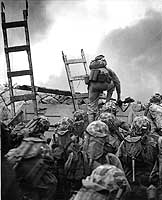
On 15 September 1950, after hurling itself fruitlessly against the Pusan Perimeter for nearly a month and a half, the weakened North Korean army was suddenly confronted with a grave threat in its rear. U.S. Marines had landed at the western port city of Inchon, near Seoul, and were poised to move inland to retake the capital and decisively cut the already tenuous North Korean supply lines.
This daring amphibious operation was conceived by General of the Army Douglas MacArthur. Though strategically tempting, Inchon was a tactically challenging amphibious target, with long approaches through shallow channels, poor beaches and a tidal range that restricted landing operations to a few hours a day. It took all of MacArthur's unparalleled powers of persuasion to sell his concept to doubting Army, Navy and Marine Corps commanders.
Forces gathered for the Inchon invasion included the First Marine Division, the Army's Seventh Infantry Division, some South Korean units, virtually every available amphibious ship, and dozens of other Navy warships. Most of the Marines had recently arrived from the U.S., while the rest were withdrawn from the Pusan Perimeter defenses.
Preliminary naval gunfire and air bombardment began on 13 September. The 1st and 5th Marines went ashore on the morning of the 15th. Resistance and casualties were modest, and initial objectives were quickly secured. Over the next several days, as supplies and troops poured ashore at Inchon, the Marines moved relentlessly toward Seoul. Kimpo airfield was taken on 17 September and was in use to support operations two days later. On 29 September, after days of hard street fighting, Seoul was returned to the South Korean government.
A hundred miles to the southeast, the Pusan Perimeter's defenders went on the offensive on 16 September. After resisting for a few days, the now-isolated North Korean army retreated and progressively collapsed during the rest of the month. On the 27th, U.S. Army units moving southwards from Seoul met those coming up from Pusan.
This page features a special image selection on the Inchon Invasion, and provides links to broader pictorial coverage of that operation.
For more pictures of the Inchon Operation, see:
For views of an important planning meeting for the Inchon Operation, see: The Joint Chiefs of Staff Meet with General MacArthur, August 1950.
For visual coverage of other aspects of the September-November
United Nations' offensive in Korea, see:
For a precis of our Korean War images, and links to more
comprehensive pictorial coverage of that conflict, see:
| If you want higher resolution reproductions than the Online Library's digital images, see: How to Obtain Photographic Reproductions. |
Click on the small photograph to prompt a larger view of the same image.
|
Photo #: NH 97053 Inchon Invasion, September 1950 Map entitled "Movement to the Objective Area", copied from "The Inchon-Seoul Operation", Volume II of "U.S. Marine Operations in Korea, 1950-53", page 83. It shows the route taken by the invasion forces to reach Inchon. U.S. Naval Historical Center Photograph. Online Image: 94KB; 740 x 525 pixels |
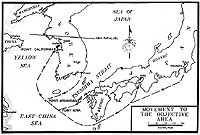 |
|
Photo #: NH 97152 Inchon Invasion, September 1950 USS Rowan (DD-782) silhouetted against the sun on 14 September 1950, as she escorts USS Mt. McKinley (AGC-7) off the Korean coast en route to Inchon. Official U.S. Army Photograph, from the collections of the Naval Historical Center. Online Image: 107KB; 740 x 600 pixels |
 |
|
Photo #: 80-G-423206 Inchon Invasion, September 1950 An LST slips into Inchon harbor in the early hours of 15 September 1950, just prior to the landings there. Official U.S. Navy Photograph, now in the collections of the National Archives. Online Image: 103KB; 610 x 765 pixels Reproductions of this image may also be available through the National Archives photographic reproduction system. |
 |
|
Photo #: 80-G-423215 Inchon Invasion, September 1950 LCVPs from USS Union (AKA-106) circle in the transport area off Inchon, prior to going to the line of departure on the first day of landings, 15 September 1950. An LST, wearing the side number QO-12, is in the center background. Official U.S. Navy Photograph, now in the collections of the National Archives. Online Image: 86KB; 740 x 610 pixels Reproductions of this image may also be available through the National Archives photographic reproduction system. |
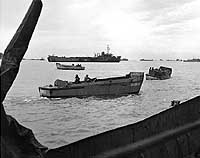 |
|
Photo #: 80-G-420024 Inchon Invasion, September 1950 A LSMR fires rockets as LVTs cross the line of departure to take Marines to Blue Beach on the first day of landings, 15 September 1950. Wolmi-Do island is in the left center background. The Inchon waterfront is in the right center distance, with heavy smoke rising from pre-invasion bombardment. Official U.S. Navy Photograph, now in the collections of the National Archives. Online Image: 73KB; 740 x 615 pixels Reproductions of this image may also be available through the National Archives photographic reproduction system. |
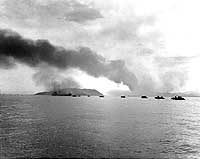 |
|
Photo #: NH 96876 Inchon Invasion, September 1950 First Lieutenant Baldomero Lopez, USMC, leads the 3rd Platoon, Company A, 1st Battalion, 5th Marines over the seawall on the northern side of Red Beach, as the second assault wave lands, 15 September 1950. Wooden scaling ladders are in use to facilitate disembarkation from the LCVP that brought these men to the shore. Lt. Lopez was killed in action within a few minutes, while assaulting a North Korean bunker. Note M-1 Carbine carried by Lt. Lopez, M-1 Rifles of other Marines and details of the Marines' field gear. U.S. Marine Corps Photograph, from the collections of the Naval Historical Center. Online Image: 97KB; 600 x 765 pixels |
 |
|
Photo #: SC 348448 Inchon Invasion, September 1950 General of the Army Douglas MacArthur (seated, center), Commander-in-Chief, Far East Command, on board USS Mount McKinley (AGC-7) during the Inchon landings, 15 September 1950. The others present are (from left to right): Rear Admiral James H. Doyle, U.S. Navy, Commander, Task Force 90; Brigadier General Edwin K. Wright, U.S. Army, MacArthur's Operations Officer, and Major General Edward M. Almond, U.S. Army, Commander, Tenth Corps. Photograph from the Army Signal Corps Collection in the U.S. National Archives. Online Image: 87KB; 590 x 765 pixels Reproductions of this image may also be available through the National Archives photographic reproduction system. |
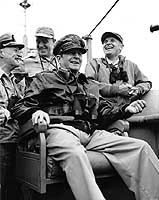 |
|
Photo #: 80-G-420027 Inchon Invasion, September 1950 Four LSTs unload men and equipment while "high and dry" at low tide on Inchon's Red Beach, 16 September 1950, the day after the initial landings there. USS LST-715 is on the right end of this group, which also includes LST-611, LST-845 and one other. Another LST is beached on the tidal mud flats at the extreme right. Note bombardment damage to the building in center foreground, many trucks at work, Wolmi-Do island in the left background and the causeway connecting the island to Inchon. Ship in the far distance, just beyond the right end of Wolmi-Do, is USS Lyman K. Swenson (DD-729). Official U.S. Navy Photograph, now in the collections of the National Archives. Online Image: 161KB; 740 x 615 pixels Reproductions of this image may also be available through the National Archives photographic reproduction system. |
 |
|
Photo #: NH 96980 Inchon Operation, September 1950 A Chaplain reads the Last Rites service as Lieutenant (Junior Grade) David H. Swenson is buried at sea from USS Toledo (CA-133), off Inchon, Korea. He had been killed by North Korean artillery while his ship, USS Lyman K. Swenson (DD-729) was bombarding enemy positions on Wolmi-do island, Inchon, on 13 September 1950. Lyman K. Swenson is in the background, with her crew at quarters on deck. Official U.S. Navy Photograph, from the "All Hands" collection at the Naval Historical Center. Online Image: 101KB; 740 x 625 pixels |
 |
For more pictures of the Inchon Operation, see:
For views of an important planning meeting for the Inchon Operation, see: The Joint Chiefs of Staff Meet with General MacArthur, August 1950.
For visual coverage of other aspects of the September-November
United Nations' offensive in Korea, see:
For a precis of our Korean War images, and links to more
comprehensive pictorial coverage of that conflict, see:
| If you want higher resolution reproductions than the Online Library's digital images, see: How to Obtain Photographic Reproductions. |
Picture caption corrected 6 February 2001